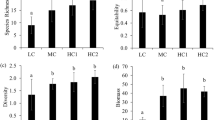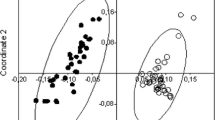Summary
An experimental investigation under field conditions of enclosures containing freshwater pulmonate snails, the macrophyteCeratophyllum demersum and epiphytes, produced evidence of beneficial interactions.Ceratophyllum growth, measured in terms of stem length, numbers of leaf-nodes and growing tips and leaf survival was significantly enhanced in the presence of snails. This effect was attributed to the increased availability of plant nutrients of snail origin, such as phosphates and ammonia, as well as to the snails' action as “cleaning symbionts” in reducing the density of bacterial and algal epiphyton potentially deleterious to macrophytes. Principal component analysis revealed both seasonal and treatment effects of snail grazing on algal epiphyton. Small adnate algal species (e.g.Cocconeis placentula) survived grazing and benefited from the removal of larger, competitor, species. Snail densities increased in all treatments, despite high (86%) juvenile mortality. It is concluded that freshwater pulmonate snails are strong interactors in lentic habitats, enhancing the growth ofCeratophyllum and producing characterisic epiphyte communities. This benefits not only the snails, but also the plants and epiphytes that are associated with them. Thus the interactions between these component parts of the community can be considered as mutualistic.
Similar content being viewed by others
References
Aram RH (1970) Studies on the population biology ofLymnaea peregra (Mull.) andPlanorbis planorbis (L.). Unpublished D. Phil Thesis, University of Sussex, UK
Arber A (1963) Water plants, a study of aquatic angiosperms. Reprint J. Cramer Weinheim. Hafner, New York
Bronmark C (1985) Interactions between macrophytes, epiphytes and herbivores: an experimental approach. Oikos 45:26–30
Bronmark C (1989) Interactions between epiphytes, macrophytes and freshwater snails: a review. J Moll Stud 55:299–311
Bronmark C, Rundle SD, Erlandsson A (1991) Interactions between freshwater snails and tadpoles: competition and facilitation. Oecologia 87:8–18
Brown KM (1982) Resource overlap and competition in pond snails: an experimental analysis. Ecology 63:412–422
Calow P (1978) The evolution of life-cycle strategies in fresh-water gastropods. Malacologia 17:351–364
Cattaneo A (1983) Grazing on epiphytes. Limnol Oceanogr 32:124–132
Cattaneo A, Kalff J (1986) The effect of grazer size manipulation on periphyton communities. Oecologia 69:612–617
Coen LD (1988) Herbivory by crabs and the nature of algal epibionts on caribbean host corals. Oecologia 75:198–203
Cuker BE (1983a) Grazing and nutrient interactions in controlling the activity and composition of the epilithic algal community in an arctic lake. Limnol Oceanogr 28:133–141
Cuker BE (1983b) Competition and coexistance among the grazing snailLymnaea, Chironomidae, and microcrustacea in an arctic epilithic lacustrine community. Ecology 64:10–15
Dethier MN, Duggins DO (1984) An “indirect commensalism” between marine herbivores and the importance of competitive hierarchies. Am Nat 124:205–219
Eisenberg RM (1970) The role of food in the regulation of the pond snail,Lymnaea elodes. Ecology 51:680–684
Fairchild GW, Sherman JW, Acker FW (1989) Effects of nutrient (N,P,C) enrichment, grazing and depth upon littoral periphyton of a softwater lake. Hydrobiologia 173:69–83
Feminella JW, Resh VH (1991) Herbivorous caddisflies, macroalgae, and epilithic microalgae: dynamic interactions in a stream grazing system. Oecologia 87:247–256
Gaten E (1986) Life cycle ofLymnaea peregra (Gastropoda: Pulmonata) in the Leicester Canal, UK with an estimate of annual production. Hydrobiologia 135:45–54
Gauch HG Jr (1984) Multivariate analysis in community ecology (Cambridge Studies in Ecology 1) Cambridge University Press, Cambridge
Gregory SV (1983) Plant herbivore interactions in stream systems. In: Barnes JR, Minshall GW (eds) Stream ecology: Application and testing of general ecological theory. Plenum Press, New York London, pp 157–189
Hill WR, Knight AW (1988) Concurrent grazing effects of two stream insects on periphyton. Limnol Oceanogr 33:15–26
Hoagland KD, Roemer SC, Rosowski JR (1982) Colonization and community structure of two periphytic assemblages, with emphasis on the diatoms (Bacillariophyceae). Am J Bot 69:188–213
Hootsmans MJM, Vermaat JE (1985) The effects of periphyton grazing by three epifaunal species on the growth ofZostera marina L. under experimental conditions. Aquat Bot 22:83–88
Hossell JC, Baker JH (1979) A note on the enumeration of epiphytic bacteria by microscopic methods with particular reference to two freshwater plants. J Appl Bacteriol 46:87–92
Howard RK, Short FT (1986) Seagrass growth and survivorship under the influence of epiphyte grazers. Aquat Bot 24:287–302
Jacoby JM (1985) Grazing effects on periphyton byTheodoxus fluviatilis (Gastropoda) in a lowland stream. J Freshw Ecol 3:265–274
Jacoby JM (1987) Alterations in periphyton characteristics due to grazing in a cascade foothill stream. Freshw Biol 18:495–508
Kairesalo T, Koskimies I (1987) Grazing by oligochactes and snails on epiphytes. Freshw Biol 17:317–324
Kesler DH (1981) Periphyton grazing byAmnicola limosa: an enclosure exclosure experiment. J Freshw Ecol 1:51–59
Lam PKS, Calow P (1989) Intraspecific life-history variation inLymnaea peregra (Gastropoda: Pulmonata) 1. Field study. J Anim Ecol 58:571–588
Lamberti GA, Ashkenas LR, Gregory SV, Steinman AD (1987) Effects of three herbivores on periphyton communities in laboratory streams. J N Am Benthol Soc 6:92–104
Lodge DM (1985) Macrophyte-gastropod associations: observations and experiments on macrophyte choice by gastropods. Freshw Biol 15:695–708
Lodge DM (1986) Selective grazing on periphyton: a determinant of freshwater gastropod microdistributions. Freshw Biol 16:831–841
Lodge DM, Kelly P (1985) Habitat disturbance and the stability of freshwater gastropod populations. Oecologia 68:111–117
Lowe RL, Hunter RD (1988) Effects of grazing byPhysa integra on periphyton community structure. J N Am Benthol Soc 7:29–36
Mat I (1988) Ecophysiological aspects of nitrogen metabolism in the freshwater snailBiomphalaria glabrata. D. Phil Thesis, University of Sussex, UK
Mason CF, Bryant RJ (1975) Periphyton production and grazing by chironomids in Alderfen Broad, Norfolk. Freshw Biol 5:271–277
Morin JO (1986) Initial colonization of periphyton on natural and artifical apices ofMyriophyllum heterophyllum Michx. Freshw Biol 16:685–694
Osenberg CW (1989) Resource limitation, competition and the influence of life history in a freshwater snail community. Oecologia 79:512–519
Peterson CG (1987) Gut passage and insect grazer selectivity of lotic diatoms. Freshw Biol 18:455–460
Porter KG (1976) Enhancement of algal growth and productivity by grazing zooplankton. Science 192:1332–1333
Power ME (1990) Resource enhancement by indirect effects of grazers: Armoured Catfish, algae and sediment. Ecology 71:897–904
Pringle CM (1990) Nutrient-spatial heterogeneity: effects on community structure, physiognomy, and diversity of stream algae. Ecology 71:905–920
Pyke DA, Thompson JN (1986) Statistical analysis of survival and removal rate experiments. Ecology 67:240–245
roemer SC, Hoagland KD, Rosowski JR (1984) Development of a freshwater periphyton community as influenced by diatom mucilages. Can J Bot 62:1799–1813
Rogers KH, Breen CM (1981) Effects of epiphyton onPotamogeton crispus L. leaves. Microb Ecol 7:351–363
Rogers KH, Breen CM (1983) An investigation of macophyte, epiphyte, and grazer interactions. In: Wetzel RG (Ed) Periphyton of Freshwater ecosystems. Junk, The Hague
Subramaniam J (1990) The biochemical ecology of freshwater communities with particular reference to the neuston. D.Phil Thesis, University of Sussex, UK
Tilman D, Kiesling R, Sterner R, Kilham SS, Johnson FA (1986) Green, bluegreen and diatom algae: taxonomic differences in competitive ability for phosphorus, silicon and nitrogen. Arch Hydrobiol 106:473–485
Thomas JD (1987) An evaluation of the interactions between freshwater pulmonate snail hosts of human schistosomes and macrophytes. Phil Trans R Soc London B 315:75–125
Thomas JD (1990) Mutualistic interactions in freshwater modular systems with molluscan components. Adv Ecol Res 20:125–178
Thomas JD, Tait AI (1984) Control of the snail hosts of schistosomiasis by environmental manipulation: a field and laboratory appraisal in the Ibadan area, Nigeria. Phil Trans R Soc London B305:201–253
Thomas JD, Nwanko DI, Sterry PR (1985) The feeding strategies of juvenile and adultBiomphalaria glabrata (Say) under simulated natural conditions and their relavance to ecological theory and snail control. Proc R Soc London B 266:177–209
Thomas JD, Kowalczyk C, Somasundaram B (1989) The biochemical ecology ofBiomphalaria glabrata, a snail host ofSchistosoma mansoni: Short chain carboxylic and amino acids as phagostimulants. Comp Biochem Physiol 93A:899–911
Underwood GJC (1991a) Note: Colonization and invasion of leaves of the aquatic macrophyteCeratophyllum demersum L. by epiphytic bacteria. Microb Ecol 21:267–275
Underwood GJC (1991b) Growth enhancement of the macrophyteCeratophyllum demersum in the presence of the snailPlanorbis planorbis: the effect of grazing and chemical conditioning. Freshw Biol 26:325–334
Underwood GJC, Baker JH (1991) The effect of various aquatic bacteria on the growth and senescence of duckweed (Lemna minor). J Appl Bacteriol 70:92–196
Underwood GJC, Thomas JD (1990) Grazing interactions between pulmonate snails and epiphytic algae and bacteria. Freshw Biol 23:505–521
van Aardt WJ, Wolmarans CT (1981) Evidence for non-assimilation ofChlorella by the african freshwater snailBulinus (Physopsis) globosus. S Afr J Sci 77 319–320
Zar JH (1984) Biostatisical analysis. 2nd edn. Prentice Hall Int Inc, New Jersey
Author information
Authors and Affiliations
Rights and permissions
About this article
Cite this article
Underwood, G.J.C., Thomas, J.D. & Baker, J.H. An experimental investigation of interactions in snail-macrophyte-epiphyte systems. Oecologia 91, 587–595 (1992). https://doi.org/10.1007/BF00650335
Received:
Accepted:
Issue Date:
DOI: https://doi.org/10.1007/BF00650335




